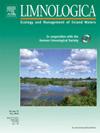智利淡水湖浮游细菌和微真核生物门群落结构的差异
IF 2
4区 环境科学与生态学
Q2 LIMNOLOGY
引用次数: 0
摘要
反映地点间扩散潜力的空间因子与当地环境条件对淡水浮游生物群落的影响尚不清楚。我们评估了当地和季节性环境条件相对于空间因素在解释39个中纬度智利湖泊浮游微生物群落组成(即β多样性模式)差异方面的相对重要性,这些湖泊跨越了海拔、混合深度和水化学的代表性生态梯度。通过16S rRNA基因V3-V4区和18S rRNA基因V4区对端高通量测序对其进行了分类分析。变异分区分析表明,环境因子和季节因子对空间变量的解释力及其相互重叠在不同的分类群和功能类群之间存在较大差异。超过12% %的群落结构变化是由浮游植物群Dinophyta, Ochrophyta和Cyanobacteria以及寡营养超微生物(oligotrophic supermicrobacteria),如含小紫红质放线菌(Actinobacteria)和LD12 Alphaproteobacteria中的环境因素唯一解释的。在吞噬异养和腐养类群中,包括异养微真核生物和拟杆菌门,环境因素解释了群落结构差异的较小甚至不显著的部分。我们的研究结果表明,在智利湖泊中,与生态和营养策略相关的复杂性状似乎影响了当地环境特性对其群落组成的相对影响,从而影响了物种沿着湖泊梯度的分选强度。本文章由计算机程序翻译,如有差异,请以英文原文为准。
Differences in community structuring among planktonic bacterial and micro-eukaryotic phyla in Chilean freshwater lakes
The effect of spatial factors reflecting dispersal potential between sites versus local environmental conditions on freshwater planktonic communities remains poorly understood. We assessed differences in the relative importance of local and seasonal environmental conditions versus spatial factors in explaining differences in community composition (i.e., beta-diversity patterns) in microbial plankton of 39 mid-latitude Chilean lakes spanning representative ecological gradients in altitude, mixing depth and water chemistry. The assemblages were taxonomically profiled by paired-end high throughput sequencing of the V3-V4 region of the 16S and the V4 region of the 18S rRNA genes. Variation partitioning analyses revealed that the explanatory power of environmental and seasonal factors versus spatial variables and their mutual overlap varied considerably among taxa and functional groups. More than 12 % of the variation in community structure was uniquely explained by environmental factors in the phytoplankton groups Dinophyta, Ochrophyta and Cyanobacteria, as well as in oligotrophic ultramicrobacteria, such as small rhodopsin containing Actinobacteria and LD12 Alphaproteobacteria. In phago-heterotrophic and saprotrophic groups, including heterotrophic micro-eukaryotes, and Bacteroidetes, environmental factors explained a smaller or even insignificant portion of the differences in the community structure. Our findings suggest that in Chilean lake microplankton, complex traits related to ecological and trophic strategy appear to affect the relative effect of local environmental properties on their community composition and hence the strength of species sorting along limnological gradients.
求助全文
通过发布文献求助,成功后即可免费获取论文全文。
去求助
来源期刊

Limnologica
环境科学-湖沼学
CiteScore
3.70
自引率
5.90%
发文量
64
审稿时长
3 months
期刊介绍:
Limnologica is a primary journal for limnologists, aquatic ecologists, freshwater biologists, restoration ecologists and ecotoxicologists working with freshwater habitats.
 求助内容:
求助内容: 应助结果提醒方式:
应助结果提醒方式:


